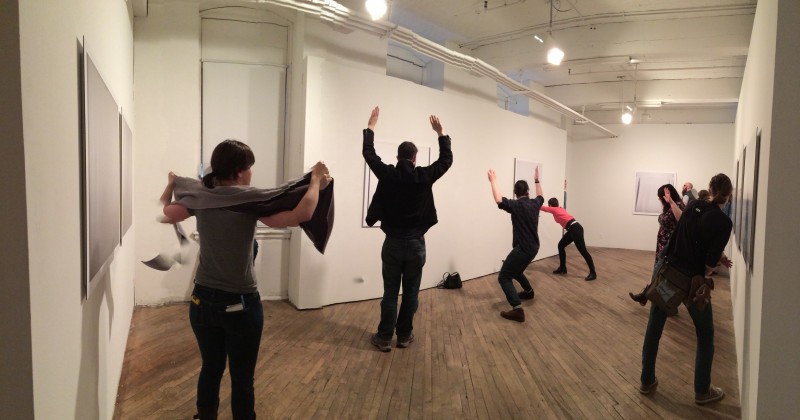
On November 25, Title Magazine editor Samantha Mitchell published a reflection—which I strongly encourage you to read—on the past limits of the online journal and its potential future. One interesting point she makes is that of the dissolution of a firm editorial objective (a “vision”) of the journal and the pressure that such a lack places on artist initiatives in Philadelphia. Without a clear objective, many initiatives fizzle out of existence.
Very often, the reason for this fizzling out is laid squarely on the individual responsibility of those involved in the initiatives—editors, artists, and collaborators in art projects are not only tasked with ‘keeping a project alive,’ but they are also burdened with full-time work, part-time jobs, neglected studio practices and, at times, relatively unstable living conditions. Therefore, it is completely understandable that they lack the energy and time to engage in, as Mitchell puts it in her article, an “outwardly thankless job” (and, not to mention, completely unpaid) of editing an online art journal.
Although I am well aware of the real conditions that artists, educators, critics, etc. face and, as a result, the difficulties of providing independent platforms on which to critically engage the art being produced in a particular place, I believe that the ostensibly inevitable dissolution of arts initiatives—especially those that require a deeper level of engagement—are not simply reducible to the lack of energy of individuals. I believe that a deeper, more complicated issue applies pressure to the longevity of artistic initiatives. It is the problem of the openness of what determines and defines the social function and import of art, and the unresolved issue of why we need it.
Shifting the perspective
One of the most distinctive things about contemporary art is that its right to exist, and our need for it to exist, is by no means self-evident. Many art initiatives in Philadelphia that focus on the reception of artistic production in the city, initiatives such as Title Magazine and The St. Claire, seem to be premised on an uncritical affirmation of art’s central importance in society. Art is of importance because it exists as something seemingly important—after all, galleries, journals, magazines, university studies, economies, and vast museums are erected in its name. From the assumption of art’s given import, a problem is artificially generated—the reception of art in this city needs to be developed.
In Mitchell’s article and Matt Kalasky’s Artblog article “What if art criticism wasn’t what we thought it was,” the necessity of art writing is simultaneously presupposed as a fixed, yet relatively oblique, need, and raised to the level of a problem that needs to be addressed. For Mitchell, critical art writing, broadly construed, is needed to explain what “art means, or is supposed to mean.” For Kalasky, it is a “chore” that we all unanimously agree is necessary.
Regrettably, what is not explained in any greater detail is what constitutes the necessity of art writing in relation to the complex problem of the necessity of contemporary art. Rather, the emphasis is shifted within the independent online art journals from the reflection on the lack of any obvious function of contemporary art to that of the problem of art writing. Within the context of Mitchell and Kalasky’s articles, art writing is, more or less, simply presumed to be a constitutive part of the production and circulation of art in Philadelphia. This presumption is what allows initiatives such as Title Magazine and The St. Claire (Kalasky is a co-editor) to generate a certain form of art reception by way of suspending the deeper problem of art’s social function. In other words, the shift in perspective—from art’s function and import to the problem of reception—produces an artificial problem, namely, the ‘lack’ of art writing about art in Philadelphia.
It is worth taking a slightly closer look at the production of this artificial problem within the context of the two journals (keeping in mind Mitchell’s project to “reimagine” Title).
Two forms of reception
With The St. Claire, we often have a sense that experimenting on the forms of art reception for its own sake is the predominant, organizing objective. This focus on experimentation is an anachronistic reshaping of an element of avant-garde practices of the twentieth century. Stripped of the connections with other social forms that avant-garde practices posed, the encouragement of experimentation with the form of art writing in forms such as ‘The Form Review’ and the recent ‘Art Writing Competition’ lacks any real sense as to why such experimentation is required. Such a lack of any clear explanation as to why experimentation is especially odd within the context of Philadelphia where even the most basic, non-experimental reception of the art produced here is lacking.
Thus, the experimental drive of The St. Claire is an ambivalent gesture since it is not polemically positioned in relation to non-experimental art writing in Philadelphia—since the latter does not exist according to the editors as “no one wants to write art criticism”—and yet, it is positioned against a certain diaphanously signaled ‘standard’ art criticism that is not explicated at the adequate level of critical observation. This ambivalence is covered over by an incessant call for a positive, energetic, alternative experimentation.
(I would like to make two parenthetical notes about the Art Writing Competition: 1. It is remarkably difficult to take Kalasky’s view that no one writes art criticism “BECAUSE IT IS BORING” seriously, not least because it seems to reduce a complex historical phenomenon—that of the development of art criticism—to the level of a relatively empty idiosyncratic cultural judgement—it is boring. It would not be very difficult to find people who find art writing interesting but, nevertheless, cannot do it. 2. It is ironic that the winning submission to the Art Writing Competition—Heather Holmes review of Wilmer Wilson’s “Shotgun Inversion” at Vox Populi—follows a relatively standard art review form or, more precisely, it does not show any signs of experimentation with the form of art writing/criticism. If anything, its strength lies in the fact that it follows relatively academic forms of intellectual legitimation—references to other institutional exhibitions and citations of other cultural practitioners such as curators and theorists.)
In contra-distinction to this drive to experiment for its own sake, Title Magazine tends to focus on reviews of exhibitions that tarry with the content of a body of work instead of offering a platform on which to experiment with the form of a review. Accordingly, the review in Title functions as a basic interpretative form—it tries to render as clearly as possible the meaning of a work. The artwork is, then, imbued with significance; it is the job of the art critic/writer to extract that meaning, to recontextualize in a review, and to potentially offer critical insight into the proposed artistic meaning of the work.
Title Magazine has been successful in providing a platform on which to publish reviews of art exhibitions in both well-known Philadelphia art institutions and lesser known ones. Over the course of the last five years, it has published over 230 reviews, which, when one considers this in relation to how long it takes to compose, edit, and publish articles, is by no means a small feat—the journal has published a review almost every single week since August 2011, adding up to over 230,00 words if the average review is 1,000 words.
Considered in light of the above, it seems odd that Mitchell is concerned with reimagining the vision of the journal and continues to insist that there is a ‘lack’ of art writing in Philadelphia. It strikes me that Title has a relatively clear vision—of providing a platform for reviews of exhibitions in Philadelphia—and, along with other independent online platforms such as The St. Claire, Speak Speak and Proximity Arts, is effective in ‘filling the gap’ of art writing on art produced in Philadelphia.
When one peruses the content of these online journals, one could state that any rhetorical invocation of the ‘lack’ of art writing focused on art in Philadelphia is, to put it bluntly, grossly misleading.
A paradoxical orientation
The supposed lack of art writing in Philadelphia does not rest on the absence of a reception but, rather, functions as a dissimulation of the very limits of the forms of reception in the online journals (in her defense, Mitchell seems to allude to such a lack at the end of her article but it is not done as concretely as perhaps it could have been). In other words, the lack of art writing is a rhetorical standpoint to hide the limits of the discourse on art that online journals provide. It also covers over the problem of how to grasp the absence of any clear meaning or function of contemporary art.
Without a reflection on such an absence, art’s importance is reduced to a kind of meta-critical tautology—art is important because it is, because it exists. Taking the importance of art as an unquestioned starting point for sheer tautological reasons produces a rather problematic obstacle in relation to organizing an objective vision for any art initiative. How can a vision about the social, political, and intellectual orientation of a contemporary arts initiative—an online journal, for example—be adequately focused when contemporary art itself does not seem to have any clear social, political, or intellectual objective?
To take this question as a spur to further inquiry as opposed to an insurmountable impasse, one could pose the following orientating proposition–it is precisely on account of the unresolved and open status of the import and function of contemporary art that an arts initiative focused on the products and expressions of contemporary art is to be potentially organized. In other words, an art initiative that seeks to form a clearer, more cogent vision needs, perhaps, to develop a standpoint in relation to the absence of any self-evident truth about art. That is to say, it needs to paradoxically render intelligible what is not at all intelligible about the general status of art. This strange paradoxical orientation, however, cannot function by itself; it has to be coupled with a critique of the sheer affirmation of the significance of art. That is, with a critique of the predetermined importance of art and all its interconnected phenomena (such as art writing).
When taken together—the paradox of the problem of the social function of contemporary art and the critique of the suspension of any deeper inquiry into the limits of its pure affirmation—a more complex relation to the problem of the social function of art can be produced, namely, that its problem is unresolved. An unresolved problem, however, does not preclude its resolution. On the contrary, an unresolved problem is a passage through which a resolution is made possible.
The lack of a discourse on lack
Without any connection to the distinct problem of modern and contemporary art—that its function, meaning, and right to exist is not at all obvious—much of the editorial-journalistic forms of reception of art in Philadelphia will end up perennially reproducing the feeling of the lack of any reception even when, arguably, no such lack actually exists. What is lacking in the platforms of the reception of art in Philadelphia—in online journals such as Title Magazine, The St. Claire, Speak Speak, Proximity Arts, Artblog and, to some extent, Curate This—is a critical discourse on the lack of meaning, import, and function of art.
The art produced in Philadelphia is not, for some miraculous reason, outside of the problem of the unresolved status of contemporary art. It is, rather, like art produced in so many other places, subject to the larger social-historical problem of art’s function. To begin to reimagine platforms of reception, I believe that constant reflection of the unresolved problem of the social function of contemporary art needs to be made.









